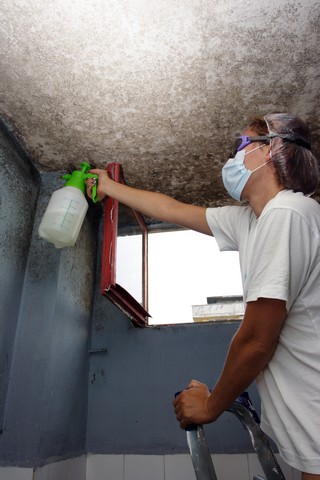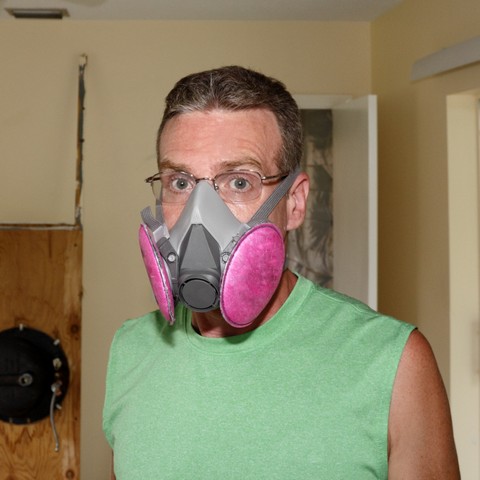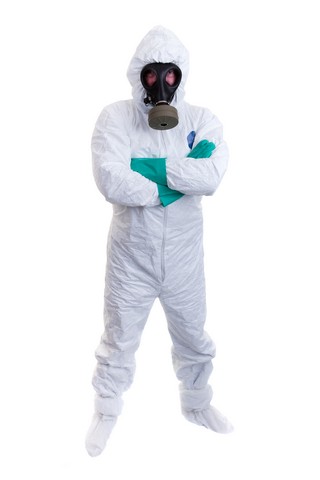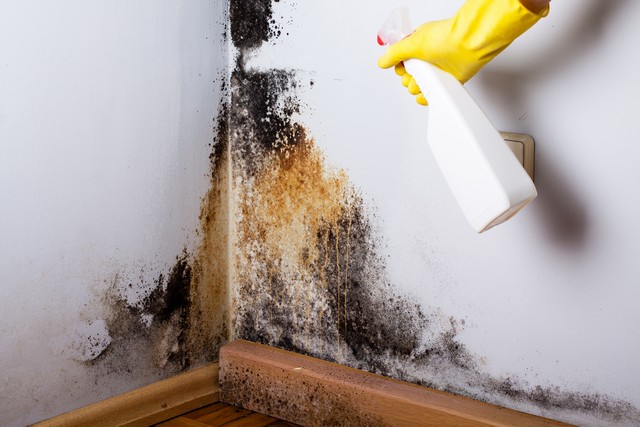Mold Removal Professionals Follow An Eight Step Process!

Pictured here is NOT a mold removal professional spraying the mold. This is not the right way to remove mold. In fact, spraying the mold will encourage further contamination because more spores will be released into the air!
To date, we have provided you with several articles on mold:
- Mold: The Facts!.
- Hiring A Mold Removal Contractor: Top 10 Questions You Should Ask!.
- 15 Health Issues Caused By Black Mold!.
- Top 7 Areas Mold Is Growing In Your Home!.
The purpose of this article is to explain what exactly happens when you hire us to remove mold from your home or business. There are eight specific steps that professionals, like NuTech Mold, follow!
If You Got Mold, Always Hire A Mold Remediation Professional!

If you have mold in your home always hire a remediation professional that does not just wear a mask, but also understands that they should protect their skin by wearing a tyvek suit!
The biggest problem facing our industry is the fact that any contractor can offer mold removal services. This is not an ideal situation because most consumers are not sure who is the best contractor to work with.
To protect yourself, it is imperative that you do your due diligence and research the references and reputation of the prospective contractors you are planning to work with. In a previous blog, we listed 10 questions that you should ask and also gave you advice on what three documents you should request from the mold removal company you are considering hiring. This article, which documents how mold removal cost is determined, should be reviewed so that you can properly prepare for the research process.
Think of it this way, when you are sick you seek out a physician who may then recommend that you see a specialist. If you are diagnosed with a sickness that requires surgery or a long term treatment, you may seek a second opinion.
Similarly, if you have mold in your home, do not just hire the cheapest or easiest option presented to you, consult with at least 3 professionals. Qualified and professional mold removal specialists have invested in education and training. Mold remediation professionals are building doctors whose objective is to assess the indoor air quality of your home and prescribe the best solution to fix the problems that are causing poor health.
Be very cautious if you get estimates from so-called mold removal contractors that recommend the following:
- Easy one-size-fits all spray or fogging solutions to magically remove all the mold in your home. Keep in mind that educated mold removal contractors understand that the procedure to remove the mold will depend on how porous the material is. Generally speaking, porous materials like drywall, carpet, etc. should just be removed and disposed of if it is contaminated with mold because most chemicals are unable to effectively penetrate the material and kill the roots.
- Do not have or recommend a containment plan. Mold is everywhere because it is a living fungi. The survival mechanism of mold is to disperse spores and find more areas to grow on and populate itself. When you have mold inside of your home, the number one concern of mold remediation professionals is to prevent the mold from spreading, ie. to contain it and prevent cross-contamination. Any contractor that does not set up a containment is not a mold removal professional and just an amateur who will do more harm than good by allowing the contamination to spread throughout the home, making your mold situation even worse.
- Recommend that bleach be used to remove the mold. Bleach is not a solution to your mold problem and never will be, particularly on porous materials.
- Do not fall for the sales pitch or claims that mold can be remediated with ozone or other types of machines that just kill mold. Killing mold is not the solution because dead mold spores can be just as harmful as live ones.
Your number one goal when you have mold in your home or business is to find the best and most experienced mold remediation contractor because you want the job done right the first time.
Yes, the service of an experienced professional may cost more, but in this industry you truly get what you pay for because effective remediation takes dedication, time, and commitment to ensure it is done properly.
Get Your Mold Removal Job Done Right The First Time: Hire Trained Professionals That Implement These 8 Steps!

Get Your Mold Removal Job Done Right The First Time: Hire Trained Professionals That Implement These 8 Steps!
Experienced and trained professionals understand that the goal is not just to remove the mold, but restore the fungal ecology of your home or business to a healthy state. With this in mind, it is important to understand that mold remediation professionals follow specific steps to ensure that the job is done right!
Step 1: Assess The Cause of The Contamination
During the mold inspection, NuTech Mold consultants will identify the source of the water infiltration that is causing the mold contamination.
Our consultants will also identify the extent of the mold growth to ensure that all areas of growth can be addressed.
The next step is to create a work plan, also known as a scope of work.
It is important that if the mold inspector you hire to do the initial investigation also does the remediation work, then a Third Party should be hired to do post-remediation verification, which is step 8 in the process.
Step 2: Identify the Species of the Mold
During the mold inspection, samples of the mold will be taken using swab or tape samples. Air quality tests may also be done. The samples are then sent to an accredited laboratory which will provide a report outlining what species of mold are present.
This report is important for three key reasons:
- It helps the mold remediation professional determine the hazard level. Some mold species, like stachybotrys, pose greater hazards and may require additional safety procedures to protect the occupants of the property.
- Identifying the species also helps determine the most cost effective method to resolve the mold problem.
- Identifying the species can also help health care professionals determine if health concerns may be related to the mold contamination.
Step 3: Scope of Work
Once the investigation is complete, the remediation plan / scope of work can be completed.
This step is important because it addresses what caused the mold and all of the safety protocols required for the remediation to be successful.
Step 4: Containment, Decontamination Chambers & Negative Air
The area is contained and negative air pressures are set and regularly monitored to prevent cross contamination of mold spores and mycotoxins to other areas of the home.
During the mold removal and remediation process mold spores become disrupted meaning spore counts can increase 10 to 100 times.
Proper procedures, containment and HEPA filtration equipment are required to prevent cross contamination.
Without these controls, the situation can become much worse than the original issue.
Step 5: Removal of the Mold
Once the containment and decontamination chamber is set up, and required negative air pressure levels are achieved the mold is removed.
Mold damaged materials such as drywall, carpet, underlay, and other porous materials are removed and disposed.
Non-porous and some semi-porous materials can be cleaned and decontaminated.
Damaged or moldy materials that are removed are then bagged or sealed with plastic sheathing before removal from the containment to prevent cross contamination.
Step 6: Odor Removal
Mold contamination can create offensive odors such as a musty basement smell.
Carbon filters are utilized to assist in the elimination of odors from the area during the remediation process.
Specialized treatments and air cleaners may be required to ensure odors do not return in the future.
Step 7: Cleaning, HEPA Vacuuming & Air Scrubbing
Once the mold contaminated materials are removed, the area must be thoroughly cleaned using antimicrobial treatments on hard surfaces and HEPA vacuuming on the porous surfaces to remove the residual mold spores.
The air must also be scrubbed and purified to remove mold spores and mycotoxins using approved DOP tested HEPA air scrubbing equipment.
Step 8: Post Remediation Verification
Post remediation verification must be conducted by an approved third party to ensure that the environment has been brought back to a normal fungal ecology suitable for occupancy.
The final clearance investigation must include a visual inspection using specialized instrumentation and a full range of air quality and surface sampling.
Got Mold Removal Questions?
NuTech Mold is here to help! If you think you have mold, call us, 470-655-1212 or contact us via e-mail for further assistance.
Eight Steps To Removing #Mold The Right Way! https://t.co/OVZGRWSs0E PLEASE RETWEET pic.twitter.com/rQpa37p5YD
— Atlanta Mold Man (@AtlantaMoldman) November 14, 2017

Recent Comments